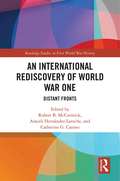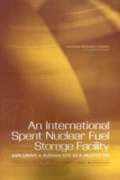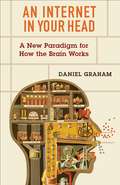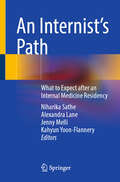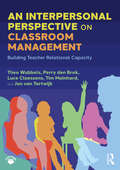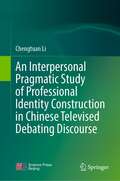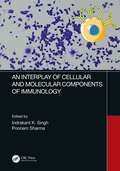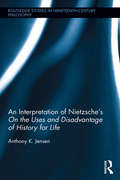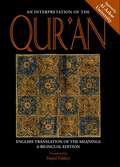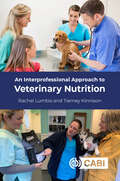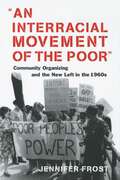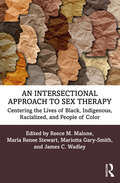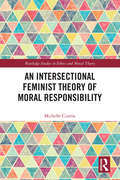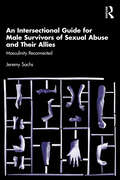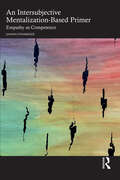- Table View
- List View
An International Rediscovery of World War One: Distant Fronts (Routledge Studies in First World War History)
by Robert B. McCormick Araceli Hernández-Laroche Catherine G. CaninoInternational contributors from the fields of political science, cultural studies, history, and literature grapple with both the local and global impact of World War I on marginal communities in China, Syria, Europe, Russia, and the Caribbean. Readers can uncover the neglected stories of this World War I as contributors draw particular attention to features of the war that are underrepresented such as Chinese contingent labor, East Prussian deportees, remittances from Syrian immigrants in the New World to struggling relatives in the Ottoman Empire, the war effort from Serbia to Martinique, and other war experiences. By redirecting focus away from the traditional areas of historical examination, such as battles on the Western Front and military strategy, this collection of chapters, international and interdisciplinary in nature, illustrates the war’s omnipresence throughout the world, in particular its effect on less studied peoples and regions. The primary objective of this volume is to examine World War I through the lens of its forgotten participants, neglected stories, and underrepresented peoples.
An International Spent Nuclear Fuel Storage Facility: EXPLORING A RUSSIAN SITE AS A PROTOTYPE
by National Research Council of the National AcademiesAs part of a long-standing collaboration on nuclear nonproliferation, the National Academy of Sciences and the Russian Academy of Sciences held a joint workshop in Moscow in 2003 on the scientific aspects of an international radioactive disposal site in Russia. The passage of Russian laws permitting the importation and storage of high-level radioactive material (primarily spent nuclear fuel from reactors) has engendered interest from a number of foreign governments, including the U.S., in exploring the possibility of transferring material to Russia on a temporary or permanent basis. The workshop focused on the environmental aspects of the general location and characteristics of a possible storage site, transportation to and within the site, containers for transportation and storage, inventory and accountability, audits and inspections, and handling technologies.
An International Study of Film Museums
by Rinella CereAn International Study of Film Museums examines how cinema has been transformed and strengthened through museological and archival activities since its origins and asks what paradoxes may be involved, if any, in putting cinema into a museum. Cere explores the ideas that were first proposed during the first half of the twentieth century around the need to establish national museums of cinema and how these have been adapted in the subsequent development of the five case studies presented here: four in Europe and one in the USA. The book traces the history of the five museums' foundation, exhibitions, collections, and festivals organised under their aegis and it asks how they resolve the tensions between cinema as an aesthetic artefact – now officially recognised as part of humanity's cultural heritage – and cinema as an entertainment and leisure activity. It also gives an account of recent developments around unifying collections, exhibition activities and archives in one national film centre that offers the general public a space totally devoted to film and cinematographic culture. An International Study of Film Museums provides a unique comparative study of museums of cinema in varying national contexts. The book will be of interest to academics and students around the world who are engaged in the study of museums, archives, heritage, film, history and visual culture.
An Internet for the People: The Politics and Promise of craigslist (Princeton Studies in Culture and Technology #26)
by Professor Jessa LingelHow craigslist champions openness, democracy, and other vanishing principles of the early webBegun by Craig Newmark as an e-mail to some friends about cool events happening around San Francisco, craigslist is now the leading classifieds service on the planet. It is also a throwback to the early internet. The website has barely seen an upgrade since it launched in 1996. There are no banner ads. The company doesn't profit off your data. An Internet for the People explores how people use craigslist to buy and sell, find work, and find love—and reveals why craigslist is becoming a lonely outpost in an increasingly corporatized web.Drawing on interviews with craigslist insiders and ordinary users, Jessa Lingel looks at the site's history and values, showing how it has mostly stayed the same while the web around it has become more commercial and far less open. She examines craigslist's legal history, describing the company's courtroom battles over issues of freedom of expression and data privacy, and explains the importance of locality in the social relationships fostered by the site. More than an online garage sale, job board, or dating site, craigslist holds vital lessons for the rest of the web. It is a website that values user privacy over profits, ease of use over slick design, and an ethos of the early web that might just hold the key to a more open, transparent, and democratic internet.
An Internet in Your Head: A New Paradigm for How the Brain Works
by Daniel GrahamWhether we realize it or not, we think of our brains as computers. In neuroscience, the metaphor of the brain as a computer has defined the field for much of the modern era. But as neuroscientists increasingly reevaluate their assumptions about how brains work, we need a new metaphor to help us ask better questions.The computational neuroscientist Daniel Graham offers an innovative paradigm for understanding the brain. He argues that the brain is not like a single computer—it is a communication system, like the internet. Both are networks whose power comes from their flexibility and reliability. The brain and the internet both must route signals throughout their systems, requiring protocols to direct messages from just about any point to any other. But we do not yet understand how the brain manages the dynamic flow of information across its entire network. The internet metaphor can help neuroscience unravel the brain’s routing mechanisms by focusing attention on shared design principles and communication strategies that emerge from parallel challenges. Highlighting similarities between brain connectivity and the architecture of the internet can open new avenues of research and help unlock the brain’s deepest secrets.An Internet in Your Head presents a clear-eyed and engaging tour of brain science as it stands today and where the new paradigm might take it next. It offers anyone with an interest in brains a transformative new way to conceptualize what goes on inside our heads.
An Internist's Path: What to Expect after an Internal Medicine Residency
by Kahyun Yoon-Flannery Niharika Sathe Alexandra Lane Jenny MelliInternal Medicine is a broad specialty that encompasses both acute and chronic conditions in all organ systems. While its breadth and varied practice settings are part of the appeal of internal medicine training, it can also be daunting to choose a path as an early career physician. This book aims to review the varied traditional and non-traditional paths that an internist’s career may take, as well as practical advice in navigating life after training. Topics covered include deciding on a fellowship, choosing the scope of practice, finding a niche within general medicine, the many roles of an internist, the job search, and career advancement tips. Also covered are many areas rarely discussed - the death of a patient, delivering bad news, getting sued, medical burnout, and more - as well as managing the work-life balance.
An Interpersonal Approach to Classroom Management: Strategies for Improving Student Engagement
by Heather A. Davis Jessica J. Summers Lauren M. MillerThe authors engage you from the start by contrasting how differently teachers respond to common situations. They expertly bridge the gap between educational psychology and classroom management from the perspectives of student engagement, peer and student-teacher relationships, and teacher self regulation. Both current and prospective teachers will find helpful tools for engaging difficult students, managing challenging relationships, and handling conflict. Key topics include: <p><p> Student behavioral, relational, and cognitive engagement in the learning process <p> Classroom structures that contribute to student engagement <p> The contribution of peer relationships to positive and negative behavior management <p> Strategies that help children learn to manage their own behavior <p> Connecting with students who are culturally and linguistically diverse
An Interpersonal Perspective on Classroom Management: Building Teacher Relational Capacity
by Tim Mainhard Theo Wubbels Perry den Brok Luce Claessens Jan van TartwijkEffective classroom management is an essential skill for teachers and student teachers alike. Packed full of practical examples and evidence-informed guidance, this book offers a comprehensive approach to classroom management that emphasises the importance of building positive teacher-student relationships and fostering a supportive classroom climate that promotes student well-being, engagement, and learning.Drawing from interpersonal theory, 40 years of research in the field, and the authors’ own experiences as teachers and teacher educators, this book offers a deeper understanding of classroom dynamics and provides strategies for navigating various classroom situations. Insightful real-life examples and hands-on practical strategies are provided throughout, as well as tools, individual and team assignments, and best practice for addressing teacher-student interactions and relationships. Its contents will help both novice and experienced teachers manage classrooms for the benefit of student development. It effectively guides readers around teacher relationships and styles, interactions during a variety of classroom situations, responding to challenging student behaviours, and creating a psychologically safe classroom.This book is an essential read for teachers, student teachers, and teacher educators across all education grade levels and subject areas who are seeking to enhance their classroom management knowledge, skills and courses. The book caters to educators at different stages of their careers, from novice teachers aiming to establish a solid foundation to experienced educators interested in refining their interpersonal approaches to classroom management.
An Interpersonal Pragmatic Study of Professional Identity Construction in Chinese Televised Debating Discourse
by Chengtuan LiThis book explores debaters’ professional identity construction through implicit negation in televised debates from an interpersonal pragmatic perspective. It reveals the linguistic strategies used to indirectly negate the identity of others, and highlights three pairs of professional identity constructed through implicit negation: (1) expert vs. non-expert identity, (2) outsider vs. insider identity, (3) authentic vs. false identity. Furthermore, it proposes the Inter-relationality Principle, self-through-other identity and other-through-self identity, which contribute to Bucholtz and Hall’s theory of identity construction. Lastly, the book discusses the relations between professional identity construction through implicit negation and im/politeness, and builds a model of professional identity construction through implicit negation based on interpersonal pragmatics. By focusing on the interpersonal pragmatics of professional identity construction, the book advances the interpersonal pragmatic study of identity construction, im/politeness and implicit negation. As such, it is a valuable resource for a broad readership, including graduate students, and scholars who are interested in professional identity construction, implicit negation and im/politeness research.
An Interplay of Cellular and Molecular Components of Immunology
by Poonam Sharma Indrakant K. SinghOur immune system defends us against infection by employing multiple lines of defense. The relevance of the immune response in human health, disease prevention, and vaccinations becomes evident when the immune system is compromised as in the case of pathogenic infections or autoimmune diseases. The reader will gain a fundamental understanding of the essential principles of immunology, such as how our immune system recognizes/fights infectious agents, how our body differentiates between foreign and self-cells/molecules, and how the memory from previous infections aids in a faster and more effective immune response. The book is divided into 17 chapters, providing an overview of the immune system and its components, including its organs and cells. Chapters on the major histocompatibility complex, the complement system, hypersensitivity and tolerance, antibody diversity through DNA rearrangements, and autoimmune diseases are included in the book which further broadens the understanding of this very complex system of our body. Chapters on transplantation immunology and vaccines provide a perspective on the application of these immunological concepts and will be of great interest to readers. Key features of the book: Simple, direct, and lucid language Comprehensive coverage of concepts for better understanding Well-labeled illustrations, flowcharts, and tables for enhanced learning Every chapter is followed up with a detailed summary and questionnaire A detailed glossary for users to know the right words Chapters contributed/reviewed by experienced experts in this field The book provides broad, accessible, and up-to-date information about immunological perspectives to biotechnologists, biomedical scientists, biochemists, molecular biologists, and students from various streams of life sciences, including zoology, biotechnology, and microbiology, as well as instant access to a wealth of information.
An Interpretation of Christian Ethics
by Reinhold NiebuhrThis addition to Westminster John Knox Press's Library of Theological Ethics series brings one of Reinhold Niebuhr's classic works back into print. This 1935 book answered some of the theological questions raised by Moral Man and Immoral Society (1932) and articulated for the first time Niebuhr's theological position on many issues. The introduction by ethicist Edmund N. Santurri sets the work into historical and theological context and also assesses the viability of some of Niebuhr's positions for theology and ethics today.
An Interpretation of Friends Worship (Start Classics)
by Jean ToomerReligious text written by American novelist and poet, Jean Toomer
An Interpretation of Nietzsche's On the Uses and Disadvantage of History for Life (Routledge Studies in Nineteenth-Century Philosophy)
by Anthony K. JensenWith his An Interpretation of Nietzsche’s "On the Uses and Disadvantage of History for Life", Anthony K. Jensen shows how 'timely' Nietzsche’s second "Untimely Meditation" really is. This comprehensive and insightful study contextualizes and analyzes a wide range of Nietzsche’s earlier thoughts about history: teleology, typology, psychology, memory, classical philology, Hegelianism, and the role historiography plays in modern culture. On the Uses and Disadvantage of History for Life is shown to be a ‘timely’ work, too, insofar as it weaves together a number of Nietzsche's most important influences and thematic directions at that time: ancient culture, science, epistemology, and the thought of Schopenhauer and Burckhardt. Rather than dismiss it as a mere ‘early’ work, Jensen shows how the text resonates in Nietzsche’s later perspectivism, his theory of subjectivity, and Eternal Recurrence. And by using careful philological analysis of the text’s composition history, Jensen is in position to fully elucidate and evaluate Nietzsche’s arguments in their proper contexts. As such Jensen’s Interpretation should restore Nietzsche’s second "Untimely Meditation" to a prominent place among 19th Century philosophies of history.
An Interpretation of the Qur'an: English Translation of the Meanings
by Majid FakhryA comprehensive and accurate rending of the Qur'an into modern English, approved by Al-Azhar University in CairoTo followers of Islam, the Qur'an is the literal word of God, revealed through Muhammad, the last of the line of prophets, containing all that is necessary to lead a life of righteousness. This new bilingual edition, approved by Al-Azhar University, the chief center of Islamic and Arabic learning in the world, offers a comprehensive and accurate rendering of the Qur'an into modern English. The clear, rigorous translation, one of the only English translations available by a native Arabic speaker, is laid out here in dual column format directly opposing the Arabic text to allow the reader to make careful verse by verse comparisons. • Approved by Al-Azhar University, Cairo • Easy-to-read translation into modern English • Index of surahs (chapters)• English and Arabic headers • Verse numbers within text in English and Arabic • Explanatory footnotes in English
An Interpretive Account to Agent-based Social Simulation: Using Criminology to Explore Cultural Possibilities
by Martin NeumannUsing the investigation of criminal culture as an example application, this edited volume presents a novel approach to agent-based simulation: interpretive agent-based social simulation as a methodological and transdisciplinary approach to examining the potential of qualitative data and methods for agent-based modelling (ABM). Featuring updated articles as well as original chapters which provide a cohesive and novel approach to the digital humanities, the book challenges the common conviction that hermeneutics and simulation are two mutually exclusive ways to understand and explain human behaviour and social change. Exploring how methodology benefits from taking cultural complexities into account and bringing these methods together in an innovative combination of qualitative-hermeneutic and digital techniques, the book unites experts in the field to connect ABM to narrative theories, thereby providing a novel tool for cultural studies. An innovative methodological contribution to narrative theory, this volume will be of primary benefit to researchers, scholars, and academics in the fields of ABM, hermeneutics, and criminology. The book will also appeal to those working in policing, security, and forensic consultation.
An Interpretive Guide to Operatic Arias: A Handbook for Singers, Coaches, Teachers, and Students
by Martial SingherA premier singer and master teacher here tells other singers how to get the most from 151 famous arias selected for their popularity or their greatness from 66 operas, ranging in time and style from Christopher Gluck to Carlisle Floyd, from Mozart to Menotti. “The most memorable thrills in an opera singer's life,” according to the author's Introduction, “may easily derive from the great arias in his or her repertoire.”This book continues the work Martial Singher has done, in performances, in concerts, and in master classes and lessons, by drawing attention “not only to precise features of text, notes, and markings but also to psychological motivations and emotional impulses, to laughter and tears, to technical skills, to strokes of genius, and even here and there to variations from the original works that have proved to be fortunate.”For each aria, the author gives the dramatic and musical context, advice about interpretation, and the lyric—with the original language (if it is not English) and an idiomatic American English translation, in parallel columns. The major operatic traditions—French, German, Italian, Russian, and American—are represented, as are the major voice types—soprano, mezzo-soprano, tenor, baritone, bass-baritone, and bass.The dramatic context is not a mere summary of the plot but is a penetrating and often witty personality sketch of an operatic character in the midst of a situation. The musical context is presented with the dramatic situation in a cleverly integrated way. Suggestions about interpretation, often illustrated with musical notation and phonetic symbols, are interspersed among the author's explication of the music and the action. An overview of Martial Singher’s approach—based on fifty years of experience on stage in a hundred roles and in class at four leading conservatories—is presented in his Introduction. As the reader approaches each opera discussed in this book, he or she experiences the feeling of participation in a rehearsal on stage under an urbane though demanding coach and director.The Interpretive Guide will be of value to professional singers as a source of reference or renewed inspiration and a memory refresher, to coaches for checking and broadening personal impressions, to young singers and students for learning, to teachers who have enjoyed less than a half century of experience, and to opera broadcast listeners and telecast viewers who want to understand what goes into the sounds and sights that delight them.
An Interpretive Guide to Operatic Arias: A Handbook for Singers, Coaches, Teachers, and Students
by Martial SingherA premier singer and master teacher here tells other singers how to get the most from 151 famous arias selected for their popularity or their greatness from 66 operas, ranging in time and style from Christopher Gluck to Carlisle Floyd, from Mozart to Menotti. “The most memorable thrills in an opera singer's life,” according to the author's Introduction, “may easily derive from the great arias in his or her repertoire.”This book continues the work Martial Singher has done, in performances, in concerts, and in master classes and lessons, by drawing attention “not only to precise features of text, notes, and markings but also to psychological motivations and emotional impulses, to laughter and tears, to technical skills, to strokes of genius, and even here and there to variations from the original works that have proved to be fortunate.”For each aria, the author gives the dramatic and musical context, advice about interpretation, and the lyric—with the original language (if it is not English) and an idiomatic American English translation, in parallel columns. The major operatic traditions—French, German, Italian, Russian, and American—are represented, as are the major voice types—soprano, mezzo-soprano, tenor, baritone, bass-baritone, and bass.The dramatic context is not a mere summary of the plot but is a penetrating and often witty personality sketch of an operatic character in the midst of a situation. The musical context is presented with the dramatic situation in a cleverly integrated way. Suggestions about interpretation, often illustrated with musical notation and phonetic symbols, are interspersed among the author's explication of the music and the action. An overview of Martial Singher’s approach—based on fifty years of experience on stage in a hundred roles and in class at four leading conservatories—is presented in his Introduction. As the reader approaches each opera discussed in this book, he or she experiences the feeling of participation in a rehearsal on stage under an urbane though demanding coach and director.The Interpretive Guide will be of value to professional singers as a source of reference or renewed inspiration and a memory refresher, to coaches for checking and broadening personal impressions, to young singers and students for learning, to teachers who have enjoyed less than a half century of experience, and to opera broadcast listeners and telecast viewers who want to understand what goes into the sounds and sights that delight them.
An Interpretive Lexicon of New Testament Greek: Analysis of Prepositions, Adverbs, Particles, Relative Pronouns, and Conjunctions
by Daniel Joseph Brendsel Gregory K. Beale William A. RossThis Interpretive Lexicon has two primary functions aimed at facilitating the exegetical and translational task, namely as a lexicon and also as an interpretive handbook. First, this book lists the vast majority of Greek prepositions, adverbs, particles, relative pronouns, conjunctions, and other connecting words that are notorious for being some of the most difficult words to translate. For each word included, page references are given for several major lexical resources where the user can quickly go to examine the nuances and parameters of the word for translation options. This book will save considerable time for students of the Greek New Testament text. For example, for the Greek preposition en (occurs 2,750 times in the New Testament) covers four pages of small print in the Bauer-Danker lexicon (BDAG). But Interpretive Lexicon digests those pages in just a few lines, with the page numbers and section references given for A Greek-English Lexicon of the New Testament and Other Early Christian Literature, 3rd Edition (BDAG, ’00) and 2nd Edition (BAGD, ’79), Greek Grammar Beyond the Basics (Daniel B. Wallace), and Prepositions and Theology in the Greek New Testament (Murray J. Harris). Thus, the translation options can be analyzed quickly. For words with a lower frequency of occurrence and fewer translation options, this book may be sufficient in itself as a lexicon. Secondly, these prepositions, conjunctions, adverbs, and connecting words in Greek, as in every language, function as explicit discourse-level markers that are essential for ascertaining the main point(s) of a passage. Therefore, this Interpretive Lexicon also evaluates the discourse function(s) of each word that is defined and catalogued, and categorizes its semantic range into defined logical relationships. This feature of the lexicon adds an interpretive element, since translation must include interpretation, at least on a linguistic level. For example, en may be translated in many ways, but those ways are categorized broadly in this book into relationships such as locative (in, among, on), means-end (with, by), grounds (because, on account of), temporal (while, at), and so on. This interpretive feature of the book is tremendously helpful for the exegetical process, allowing for the translator to closely follow the logical flow of the text with greater efficiency. This Interpretive Lexicon is thus a remarkable resource for student, pastor, and scholar alike.
An Interprofessional Approach to Veterinary Nutrition
by Tierney Kinnison Rachel LumbisIn veterinary practice, the interface between veterinarians, veterinary nurses or technicians, and paraprofessional team members is crucial. It influences patient care, incidence of medical errors, client satisfaction, success of the veterinary practice and revenue generation. Ensuring a coherent approach to the maintenance of animal health and wellbeing is of paramount importance, yet challenges such as interprofessional prejudice, misunderstanding of motivations, and a lack of recognition, respect, empowerment or trust, can prevent best practice. Nutrition is one of the most important considerations in the maintenance of health, and plays a critical role in disease management, patient recovery and hospital outcome; a reflection of its recognition as the fifth vital assessment. Owners are increasingly aware of the role of nutrition in optimising pet health, yet considerable misinformation can make this one of the most difficult aspects of pet ownership. Playing a central role as a source of expert information, veterinary healthcare teams must rise to the challenge of optimising pet nutrition. Effective interprofessional communication and collaboration is considered a key factor in the successful implementation of nutritional assessment, and a positive team environment founded on respect, trust and mutual support helps overcome challenges and provide the best outcome for both pets and their owners. This book provides evidence-based theory in an accessible and practical way to help veterinary healthcare teams implement interprofessional approaches to nutritional care and support.
An Interracial Movement of the Poor: Community Organizing and the New Left in the 1960s
by Jennifer FrostChoice Outstanding Academic Title 2002 Community organizing became an integral part of the activist repertoire of the New Left in the 1960s. Students for a Democratic Society, the organization that came to be seen as synonymous with the white New Left, began community organizing in 1963, hoping to build an interracial movement of the poor through which to demand social and political change. SDS sought nothing less than to abolish poverty and extend democratic participation in America. Over the next five years, organizers established a strong presence in numerous low-income, racially diverse urban neighborhoods in Chicago, Cleveland, Newark, and Boston, as well as other cities. Rejecting the strategies of the old left and labor movement and inspired by the Civil Rights Movement, activists sought to combine a number of single issues into a broader, more powerful coalition. Organizers never limited themselves to today's simple dichotomies of race vs. class or of identity politics vs. economic inequality. They actively synthesized emerging identity politics with class and coalition politics and with a drive for a more participatory welfare state, treating these diverse political approaches as inextricably intertwined. While common wisdom holds that the New Left rejected all state involvement as cooptative at best, Jennifer Frost traces the ways in which New Left and community activists did in fact put forward a prescriptive, even visionary, alternative to the welfare state. After Students for a Democratic Society and its community organizing unit, the Economic Research and Action Project, disbanded, New Left and community participants went on to apply their strategies and goals to the welfare rights, women’s liberation, and the antiwar movements. In her study of activism before the age of identity politics, Frost has given us the first full-fledged history of what was arguably the most innovative community organizing campaign in post-war American history.
An Intersectional Approach to Sex Therapy: Centering the Lives of Indigenous, Racialized, and People of Color
by James C. Wadley Reece M. Malone Marla Renee Stewart Mariotta Gary-SmithWhen a Black, Indigenous, or racialized individual or relationship works with a sex therapist, a host of cultural circumstances can contribute to intimacy discord and sexual dysfunction. This collection brings together clinicians and educators who share their approaches, bridging sex therapy with a client’s relationship to their racial, cultural, and ethnic identity. This essential book aims to enhance therapists’ supervisory practices and clinical treatments when working with culturally diverse and marginalized populations, fostering greater understanding and awareness. Innovative tools that integrate the impacts of acculturation, minority status, intersectionality, and minority stress are discussed, with case studies, demonstrations, and critical questions included. This collection is a necessary read for anyone who is training to be or who is an established sex therapist, marriage and family therapist, relationship counselor, or sexuality educator and consultant.
An Intersectional Feminist Theory of Moral Responsibility (Routledge Studies in Ethics and Moral Theory)
by Michelle CiurriaThis book develops an intersectional feminist approach to moral responsibility. It accomplisheses four main goals. First, it outlines a concise list of the main principles of intersectional feminism. Second, it uses these principles to critique prevailing philosophical theories of moral responsibility. Third, it offers an account of moral responsibility that is compatible with the ethos of intersectional feminism. And fourth, it uses intersectional feminist principles to critique culturally normative responsibility practices. This is the first book to provide an explicitly intersectional feminist approach to moral responsibility. After identifying the five principles central to intersectional feminism, the author demonstrates how influential theories of responsibility are incompatible with these principles. She argues that a normatively adequate theory of blame should not be preoccupied with the agency or traits of wrongdoers; it should instead underscore, and seek to ameliorate, oppression and adversity as experienced by the marginalized. Apt blame and praise, according to her intersectional feminist account, is both communicative and functionalist. The book concludes with an extensive discussion of culturally embedded responsibility practices, including asymmetrically structured conversations and gender- and racially biased social spaces. An Intersectional Feminist Approach to Moral Responsibility presents a sophisticated and original philosophical account of moral responsibility. It will be of interest to philosophers working at the crossroads of moral responsibility, feminist philosophy, critical race theory, queer theory, critical disability studies, and intersectionality theory.
An Intersectional Guide for Male Survivors of Sexual Abuse and Their Allies: Masculinity Reconnected
by Jeremy SachsFew experiences carry more shame, stigma, and misunderstanding than the life-altering trauma of sexual abuse. Men who experience sexual abuse and rape, often find themselves marginalised and isolated, yet there are few resources available for them or those who support them.This book examines the impact of sexual abuse on different men through an intersectional lens, exploring how their unique identities, circumstances, and society's views affect their recovery or compound their trauma. Each chapter addresses a topic chosen by hundreds of male survivors who have attended the author’s recovery groups. It includes survivor testimonies, signposts to resources, and reflective activities to help manage the aftermath of sexual trauma. With statutory services, such as the criminal justice system, often failing male survivors, the book draws on Transformative Justice principles to suggest alternative ways for men to break cycles of trauma and move forward with their lives.Aimed at male survivors and those who support them—counsellors, psychotherapists, social workers, family members, and loved ones—this book offers guidance and hope for navigating a path to healing.
An Intersubjective Mentalization-Based Primer: Empathy as Competence
by Johann SteinbergerThis book explores how Affect Resonance Training (ART), as developed by the Viennese psychotherapist Johann Steinberger, offers students and trainees in psychosocial professions the opportunity to develop competence in empathy, allowing them to better understand themselves and others.Based on concepts of empathy, resonance and mentalization, this innovative mode of teaching offers effective tools and training for empathetic understanding. This book presents clear instructions for its application in the classroom, summarizing several years of intensive institutional practice. The book also outlines the program’s rich theoretical background and documents its empirical effectiveness.With clear instruction on the use of ART and clinical insights on how increased empathy is effective in therapeutic settings, this book is essential reading for psychoanalysts, psychotherapists, and others across the psychosocial professions.
